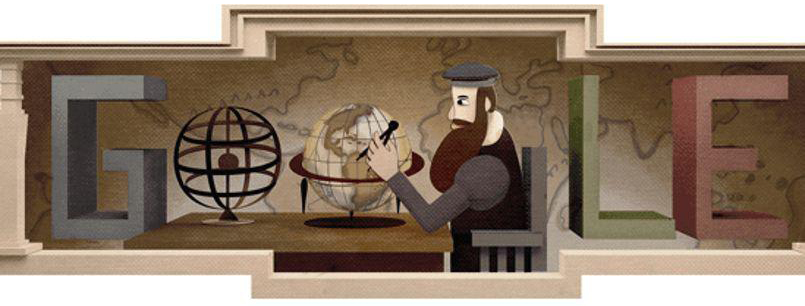Where to find Mercator globes

Doodle réalisé le 5 mars 2015 à l’occasion 503e anniversaire de la naissance de Gérard Mercator. © Google.com
Apart from the very first globes he made for Chancellor Nicholas de Granvelle (the terrestrial model, in 1541) and Bishop George of Austria (the celestial model, in 1551), and the numerous ones commissioned by Joachim Camerarius for the Frankfurt fairs and by the printer Christophe Plantin in Antwerp, Mercator no doubt sold other pairs to the University of Leuven, Duisburg Gymnasium and various schools in Belgium and Germany, as well as to abbeys, convents and individuals interested in the sciences.
It is not known how many globes were printed and assembled altogether. Since they were never copied or updated, they gradually became obsolete as new geographical discoveries were made in the second half of the 16th century. Production eventually ceased.
At present fewer than 30 documented copies still exist, along with a set of printed paper gores. Either in pairs or singly, nearly all these globes are located in Europe. A scarce few can be found in the US and Japan. The largest numbers are in Germany and Austria, followed by the UK, Belgium, France, Italy, the Netherlands, Poland, Sweden and Switzerland. All belong to public institutions such as museums, monasteries, observatories or universities. There is no known private market for these artefacts.
Find out more
- Inventory of surviving globes : based on Peter van der Krogt’s inventory,
- Krogt, P. van der (1993) Globi Neerlandici : the production of globes in the Low Countries, (trad. E. Daverman), Utrecht : HES Publ.
- Mercator, G., De Smet, A.E.J., Raemdonck, J. van (1968) Les sphères terrestre & céleste de Gérard Mercator, 1541 et 1551 : reproductions anastatiques des fuseaux originaux gravés par Gérard Mercator et conservés à la Bibliothèque royale à Bruxelles / préface Antoine De Smet ; [introduction] J. van Raemdonck extraite des Annales du Cercle archéologique du Pays de Waas, vol. 5, 1872-1875, Bruxelles : Culture et Civilisation, Adam [Jos].